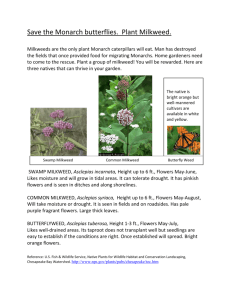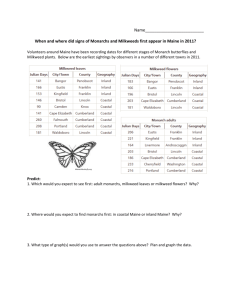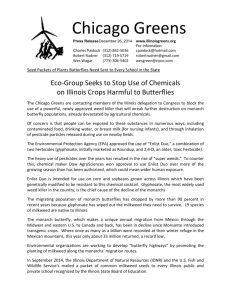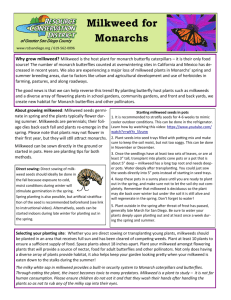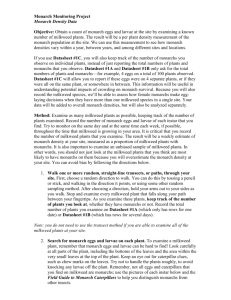Monarchs & Milkweed
advertisement
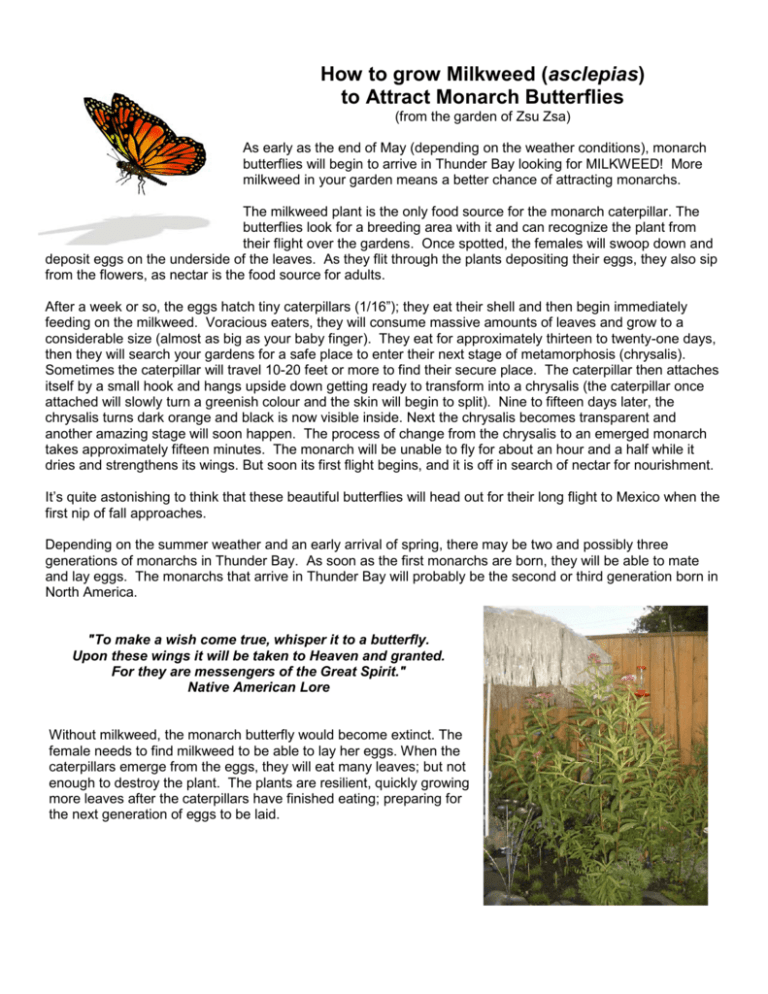
How to grow Milkweed (asclepias) to Attract Monarch Butterflies (from the garden of Zsu Zsa) As early as the end of May (depending on the weather conditions), monarch butterflies will begin to arrive in Thunder Bay looking for MILKWEED! More milkweed in your garden means a better chance of attracting monarchs. The milkweed plant is the only food source for the monarch caterpillar. The butterflies look for a breeding area with it and can recognize the plant from their flight over the gardens. Once spotted, the females will swoop down and deposit eggs on the underside of the leaves. As they flit through the plants depositing their eggs, they also sip from the flowers, as nectar is the food source for adults. After a week or so, the eggs hatch tiny caterpillars (1/16”); they eat their shell and then begin immediately feeding on the milkweed. Voracious eaters, they will consume massive amounts of leaves and grow to a considerable size (almost as big as your baby finger). They eat for approximately thirteen to twenty-one days, then they will search your gardens for a safe place to enter their next stage of metamorphosis (chrysalis). Sometimes the caterpillar will travel 10-20 feet or more to find their secure place. The caterpillar then attaches itself by a small hook and hangs upside down getting ready to transform into a chrysalis (the caterpillar once attached will slowly turn a greenish colour and the skin will begin to split). Nine to fifteen days later, the chrysalis turns dark orange and black is now visible inside. Next the chrysalis becomes transparent and another amazing stage will soon happen. The process of change from the chrysalis to an emerged monarch takes approximately fifteen minutes. The monarch will be unable to fly for about an hour and a half while it dries and strengthens its wings. But soon its first flight begins, and it is off in search of nectar for nourishment. It’s quite astonishing to think that these beautiful butterflies will head out for their long flight to Mexico when the first nip of fall approaches. Depending on the summer weather and an early arrival of spring, there may be two and possibly three generations of monarchs in Thunder Bay. As soon as the first monarchs are born, they will be able to mate and lay eggs. The monarchs that arrive in Thunder Bay will probably be the second or third generation born in North America. "To make a wish come true, whisper it to a butterfly. Upon these wings it will be taken to Heaven and granted. For they are messengers of the Great Spirit." Native American Lore Without milkweed, the monarch butterfly would become extinct. The female needs to find milkweed to be able to lay her eggs. When the caterpillars emerge from the eggs, they will eat many leaves; but not enough to destroy the plant. The plants are resilient, quickly growing more leaves after the caterpillars have finished eating; preparing for the next generation of eggs to be laid. The fall winds carry milkweed seeds to new locations in your gardens or you may collect and save these seeds for planting in the fall for next year’s blooms (and don’t forget to share them with your gardening friends)! The more milkweed you have in your garden, the more monarchs you will see. These butterflies are a delight for all ages! Mature Milkweed Seeds How to Grow: For best germination of seeds, plant directly into pots, keeping the soil moist but not soggy until germination has occurred. Plant your new milkweed in the garden when it has grown at least three sets of leaves. Or better yet, seeds can be directly planted into garden in late fall, since they require stratification (freezing of the seed). However, some gardeners have had success starting the seeds without stratification. Milkweed does best in full sun, but can tolerate some shade. Both of these varieties are pink in colour and grow to a height of 3-4 feet, branching out to about 1-2 feet when mature (second year of growing). Most milkweed will flower the first year and produce seedpods, which can be left to scatter in your gardens OR you may choose to pick the mature pods and either plant in another area or keep for germinating in the springtime of the next year. Asclepias incarnata ‘pink swamp’ (blooms mid July to mid August) Asclepias incarnata ‘soulmate’ (blooms mid August to mid September) This variety of milkweed is not invasive by root. To reduce spreading by seed, you may want to remove seed heads before they mature on the plants. In fall or spring, cut back the old milkweed stalks back to an inch high…do not pull out the old stalks (the new plant will grow from the base of the old stalk from the previous year!). Interesting internet sites to visit: http://www.learner.org/jnorth/monarch (you can input your monarch information on their site—first milkweed to emerge in the spring and also first sighting of a monarch) http://www.monarchwatch.org (provides monarch butterfly information and also monarch waystation information and you can join the monarch waystation program!) If you wish to be notified of Zsu Zsa’s annual garden sale each June, please send an email to gardenofzsuzsa@yahoo.com and you will be advised of the details. Milkweed plants are available beginning May and all throughout the summer. Zsu Zsa’s ultimate goal is to make Thunder Bay the monarch capital of the north.
